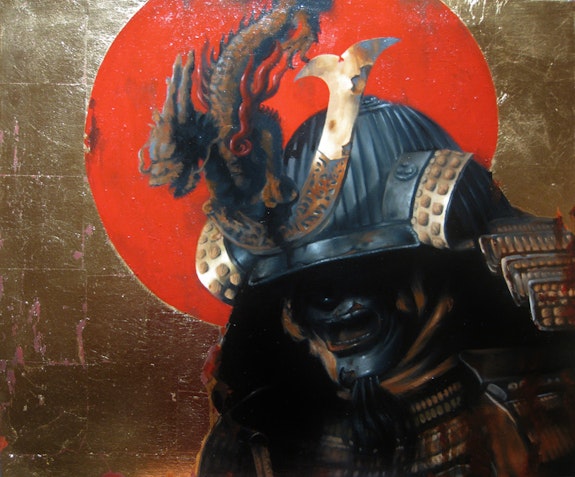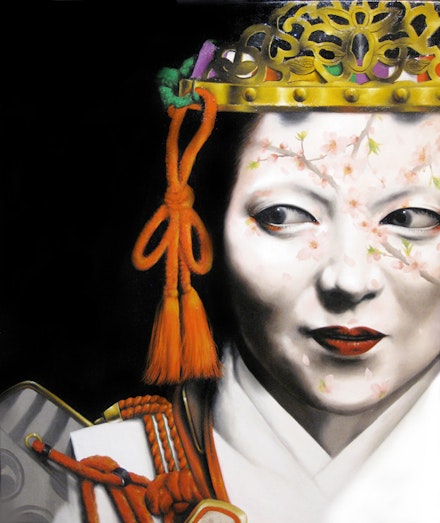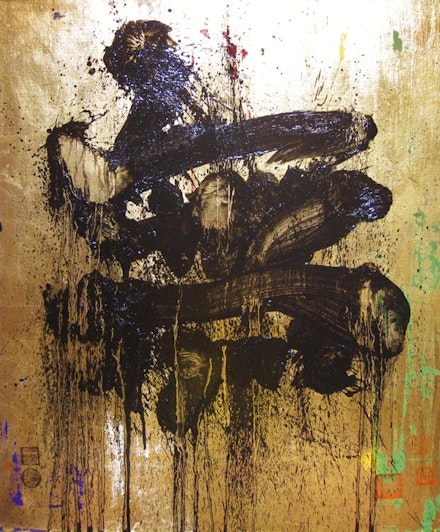ArtSeen
ATSUKI SETTANGELI:
New Dawns of the Samurai Spirit
On View
WhiteBoxJuly 6 – July 23, 2018
New York
Japanese painter Atsuki Settangeli’s striking works at WhiteBox draw their inspiration from impressive sources—the Italian Renaissance, Classical Greek culture, and American Photorealism of the 1960s and ’70s—yet the artist’s chore was not to offer a super-realistic depiction of actual objects but rather apparitions gleaned from his own imagination in carefully executed oil paintings, each made from beginning to end over the course of one day.
Settangeli pledged to devote his considerable gifts and career to the ideals of the Samurai, Japanese warriors from the 10th through 19th centuries, and their six virtues: filialness, loyalty, fidelity, justice, charity, and courtesy. Like a Samurai, he said, Settangeli shuns power, money, fame or other worldly concerns. Yet pricey Mauri Clan and Edo Period helmets, armor, and arrows from his collection punctuated the display of his manifested vision, which included twenty-four carefully rendered works, all titled “Samurai Spirit” and numbered chronologically. Simply framed in light-colored wood, most works were on black backgrounds and featured a black samurai helmet shielding a black science-fiction-like warrior mask, sporting severe facial expressions. Other armor, symbols, and embellishments adorned individual images.
Born in 1968, in Tokyo, Settangeli was recognized for his painting at the early age of sixteen, when he was awarded the Grand Prix at the 34th All-Students Oil Painting Competition for his remarkable dexterity. He began his career as an artist in 1995, committed to changing the theme and focus of his artwork every three years. He moved from content like esoteric Buddhism to a ceiling mural of seven angels, from which he took his name: Sette angeli.
Once acquainted with Samurai culture and aesthetics in 2010, however, and after a few early iterations of this new subject matter, Yoko Ono, upon a viewing at her residence in the Dakota that same year, suggested that Atsuki not cease painting Samurai.
Thus, Samurai Spirit #25 (2016), generated six years later, featured a large, bushy eagle atop a close-up of a black mask, all obscured by asemic orange calligraphy and possible eye-chart symbols. A red circle in the background, seen throughout the show, invoked the Japanese flag. Samurai Spirit #26 (also from 2016) featured a gold lunar orb behind the faintest face there, blending soft focus into the dark background with a crescent-moon shape rising like horns in the foreground.
2017’s #55 had a mechanical look. A thin white line circumscribed an eclipse-like circle behind the Darth Vader-esque head. The robotic icon was on white and uniquely surrounded by a black-and gold-flowered mat, one of two pencil drawings in this exhibition predominately of oils on canvas. In #67 (2018), a gold, multi-armed Buddha shows praying hands while gripping a scepter with index and pinkie extended atop a helmeted, bearded face secured by a rainbow cord—a traditional spiritual symbol—under its chin. Elsewhere, adorned by a yellow circle, a head cut off just below the jaw, or a tricolor French flag superimposed on a happy woman’s face lingered above yet another soldier’s head.
Also created this calendar year were two images, one light and one dark, that personified the six virtues and their opposites. The curator, Kyoko Sato, who created the large Colossal World survey of Japanese art at WhiteBox and Forsaking Pop featuring young Japanese artists, recommended the artist paint some women samurai in honor of the #MeToo movement. Settangeli obliged, acknowledging that while the age of Samurai was male-dominated, some outstanding female role models did exist, such as Tomoe-gozen and Princess Kai, both of whom emerged as concubines. So in #69, with a close-up of a white geisha girl-like warrior in a white kimono, a pink blossom twig across her face, wearing a rainbow headband under a gold crown decorated with religious purple, green, and red ropes; and Samurai Spirit #71, a grayscale painting of a woman, her open-mouthed face scratched and vertically sliced à la Lucio Fontana conveying violence, and enlarging his vocabulary, the artist created female imagery based on historical figures.
Three antique arrows hung above three powerful images with white, gray, and black backgrounds, respectively: Samurai Spirit #15 (2012) included a red lobster with a yellow-and-black shield on a flat base; #28 (2016), a gold octopus on a black helmet, reminiscent of shokushu goukan, a dark element of Japanese culture, contrasted against an inscription translated as “good luck” on #12 (2011), an image depicting a black dolphin with an ugly face and painterly gold fins, resting on a thicker base. These three works impart a sensuous playfulness that the helmets do not.
The artist has claimed each of the world’s 7.4 billion people to be “a unique nuanced color” charged with their own expression. He posed to New York viewers a question particular to his own mission: Can a commitment to spirituality survive within today’s dependence on capitalism, whereas money and materialism weren’t relevant to Samurai lives?
Atsuki Settangeli told me he works without regard for worldly concerns, his conscious brain half asleep, “dormant but not empty” in a “highly concentrated mental state.” He completes each painting within twenty-four hours, in a single sitting, with a pre-existing focus that anticipates what will become the finished hyperrealistic work. If he didn’t, he said, “the brush would not move.”




